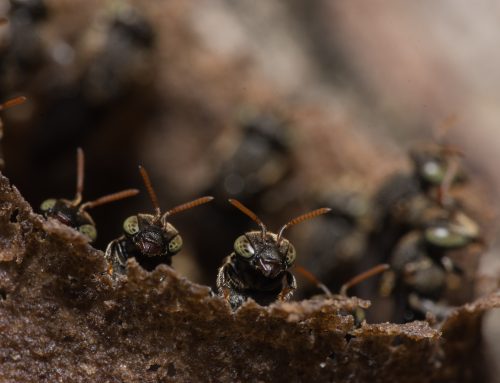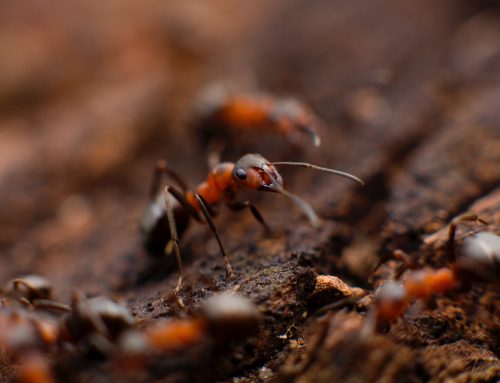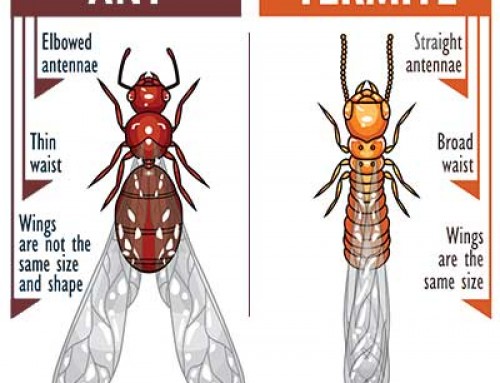In late 2011 and early 2012, the National Pest Management Association (through the Professional Pest Management Alliance), in cooperation with Dr. Laurel Hansen of Spokane Falls Community College and the University of Washington, asked pest management firms from across the United States to participate in a self-administered online survey about ants. In all, more than 200 firms from 37 different states completed the survey, reporting their observations about ant infestations in residential and commercial structures. Of the 215 pest management firms that completed the survey, 100 percent treated structures for ants in 2011. The majority of the firms had fewer than 25 team members, but 15 percent had more than 100 people employed with their companies. On average, participating companies derived about 25 percent of their annual revenue from nuisance ant control work.
The ant species reported that was treated most commonly was the carpenter ant (Camponotus spp.), with 66 percent of participants reporting them as the most commonly encountered nuisance ant species. Sixty-one percent of professionals reported that their clients had knowledge of the potential for structural damage that carpenter ants can inflict, which may account, in part, for the higher percentage of service calls related to carpenter ants. In all, more than a dozen ant species were indicated as pests by participants, including:
- Odorous house ants (Tapinoma sessile) — 62 percent
- Pavement ants (Tetramorium caespitum) — 59 percent
- Pharaoh ants (Monomorium pharaonis) — 36 percent
- Little black ants (Monomorium minimum) — 31 percent
- Argentine ants (Linepithema humile) — 28 percent
- Red imported fire ants (Solenopsis invicta) — 24 percent
- Acrobat ants (Crematogaster spp.) — 20 percent
- Crazy ants (various species including Paratrechina spp. or Nylanderia spp.) — 20 percent
Other species like white footed ants and ghost ants were frequently encountered on a local scale in certain geographic regions, but due to their limited impact nationwide, were reported by fewer professionals.
More than half of professionals (54 percent) report that ant infestations are increasing, with odorous house ants being encountered at an increased rate by 57 percent of professionals. The next most commonly reported species on the rise (pavement ants) barely had one third of the responses garnered by odorous house ants. The omnivorous feeding habits and predilection for nesting virtually anywhere may account for the odorous house ant becoming a top priority nationwide.
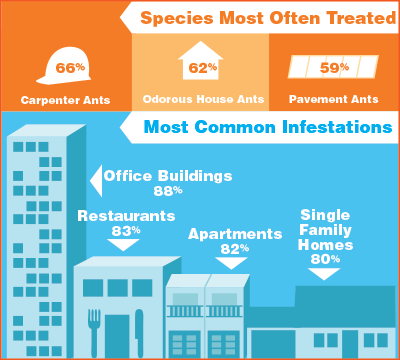
Why the increase? There are many theories about why ant calls seem to be on the rise. When asked to speculate about why ant calls are increasing in their regions, the most common reason cited was increased moisture levels (27 percent). Some professionals report that odorous house ant calls often spike after heavy rain events because honeydew produced by insects like aphids and scale insects (an important food source for odorous house ants) is washed away, leaving ants to seek alternative sustenance indoors. Odorous house ants are also notorious for moving their colonies from one nesting site to another, so heavy rains may cause colonies to seek higher (or dryer) ground indoors.
Twenty-two percent of professionals encountering increased calls for ant control services cite changing pest management practices as the reason for heightened ant activity. In recent years, clients have requested an increased amount of “exterior only” services, and fewer preventative inspections and treatments are taking place indoors. Additionally, when indoor applications are made, targeted applications to cracks and crevices have replaced general surface applications to baseboards and less product is being applied.
Professionals also cite lower pest tolerance levels (17 percent) and greater numbers of exotic ant species (14 percent) like white footed ants, ghost ants and Caribbean/Rasberry crazy ants as reasons for the increased ant pressure.
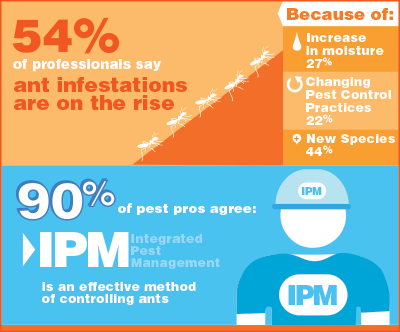
Other Findings. It’s not just homeowners who are utilizing pest management professionals to help control their ants. Eighty-eight percent of pest management professionals report encountering ants in office buildings, 83 percent report ants in restaurants, 82 percent in apartments and 80 percent in single family homes. On the interior of these structures, ants were most commonly found in kitchens (96 percent) and bathrooms (89 percent). This is not surprising as both of these sites have readily accessible moisture sources, which the most commonly reported ants (carpenter and odorous house ants) both prefer.
Based on the survey results, 90 percent of pest management professionals believe that implementing the basic tenets of IPM, including monitoring, sanitation, exclusion and population reduction is an effective approach to controlling ants. Fifty-seven percent report making sanitation recommendations to their customers about cleaning up food and water sources on the property and eliminating vegetation in contact with the structure to help reduce ant populations.
Although 40 percent of the respondents report having used non-chemical, or green methods exclusively to control ants, only 10 percent believe that ant infestations can successfully be eliminated without using traditional ant control products. In fact, professionals report that only 16 percent of their customers prefer “green” methods when it comes to controlling ants. Professionals most commonly describe their clients as frustrated (18 percent) and wanting quick results (18 percent). Unfortunately, 81 percent of professionals indicate that two or more services are typically required to gain control, which presents a challenge to customer satisfaction.
When ants are found, nearly all (95 percent) pest professionals employ the use of exterior perimeter treatments as part of a control program. With the advent of new pyrethroid label directions, pest management firms should review existing treatment protocols and review changes with technicians to ensure that company treatment protocols are in compliance with updated directions for use. Although new pyrethroid label directions may require technicians to avoid treating sites that were commonly treated in the past, focusing on source locations and ant interception points will enable the thoughtful technician to successfully control ants while meeting the requirements of the new label directions. In addition to exterior perimeter treatments, firms employed interior bait applications (81 percent), direct nest treatments (65 percent), interior insecticide applications (63 percent) and broadcast baits (55 percent) as common methods of population reduction.
By participating in this survey, PMPs from across the country have helped to shed additional light into America’s No. 1 nuisance pest. Based on their responses, species like the odorous house ant are of major concern to pest management professionals and will continue to warrant the attention of technicians and concerned homeowners alike.
By Jim Fredericks | August 31, 2012
The author is director of technical services at the National Pest Management Association.
Pest Control Magazine Online




